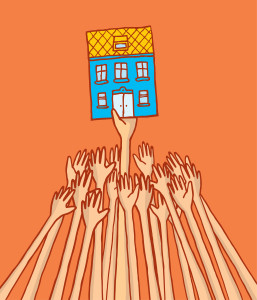 Housing Crunch
Housing Crunch
Lately, it seems, not a day goes by without hearing another “horror story” about the housing crunch in Silicon Valley and the Bay Area. From the proverbial “million dollar shack” to Mountain View backyard tents offered for rent at $900 per month, the hazards of navigating the rocky shoals of our local market loom large. Several striking incidents in recent weeks illustrate this situation:
- A client of mine reported to me that, when he asked some 30-ish friends of his who take Caltrain daily from San Francisco to Sunnyvale if they ever thought about saving commute time by moving down the Peninsula, they replied, “Oh, never! We have a rent controlled apartment – two bedrooms with a view!”—as though that ended the discussion.
- In Alameda, a City Council meeting at which a temporary moratorium on rent increases of more than 8% was debated and adopted was interrupted when tempers flared, resulting in the arrests of two men for their roles in violent outbursts occurring during that meeting.
- Sadly, in an incident attracting worldwide notice, Marie Hatch, the 97-year-old Burlingame woman who was being evicted from her home after 66 years because the owner wanted to sell the property, has died; her attorneys claim that her death was due to the stress of the eviction, and have vowed to continue the fight on behalf of Ms. Hatch’s family and her 85-year-old roommate.
Our booming local economy.
The cause of all this angst appears clear: Our booming local economy. Over the last few years, there has been a substantial increase in employment in the Bay Area and Silicon Valley, as the tech sector and other related industries (e.g., commercial construction) have taken off again, fueling growth. Between 2010 and 2013, employment in the Bay Area grew 9.8% (compared to 6.6% for California and 4.7% nationwide), while its gross regional product during that same period increased by 10.7% (compared to 6.6% in California and 6.1% in the nation).
Despite the good news on these fronts, however, the supply of housing has not kept up the pace of this growth. In an ideal economy, the jobs/housing ratio would be 1:1 or close to it, with one new housing unit added for each new job. In 2011, however, for the entire Bay Area, the ratio was 1.2:1 and trending higher, with San Francisco and some other areas having even higher ratios. Unsurprisingly, between 2010 and 2014, average rents in the Bay Area increased by 44%.
The City of Alameda provides a pointed example of how these developments play out in practice. At the recent unruly Alameda City Council meeting highlighted above, it was related that median household income there rose 29% between 2000 and 2013. While this report was good news, it was more than offset by the fact that the median rents there increased 54% during that same period. As in Alameda, these realities have led to calls in other Bay Area communities for solutions to this dilemma, including the adoption or expansion of rent control.
In San Mateo County, the Board of Supervisors recently established a task force to examine policies to increase affordable housing. Those policies being studied include the adoption of rent control and/or rent stabilization in the unincorporated areas of the county subject to its jurisdiction. In response to housing industry proposals for increased housing development and opposition to rent control, Daniel Saver, an attorney with East Palo Alto’s Community Legal Services, argued that “we cannot build our way out of the crisis.”
Rent control/rent stabilization is off the table
In contrast, rent control/rent stabilization is off the table in Mountain View, where the City Council recently advised at a lengthy, contentious meeting that a majority of that body would not support such legislation in response to that city’s high housing costs. As an alternative, the City Council proposed a package of renters’ rights proposals that some of its members hoped would provide some stability to the city’s residential tenants. These proposals include mandatory mediation for landlord-tenant disputes, a 90-day notice period for rent increases or evictions, and requiring landlords to offer six to 12 month term leases in addition to month-to-month rentals. The Council asked that staff prepare an ordinance including these provisions, to be considered on an urgency basis.
In San Jose, which enacted its own rent control ordinance in 1979, the City Council recently adopted a proposal to make tenant protection under that ordinance stronger after emotional testimony from both landlords and tenants. By a 9-2 vote, the Council approved a measure that would explore (a) reducing the existing cap on rent increases of 8%, (b) making changes to existing law that permits new landlords to pass mortgage costs on to tenants, (c) establishing a “just cause” requirement for evictions, and (d) expanding coverage of the rent control ordinance to duplexes. These changes would add to the 43,000 housing units currently subject to rent control in San Jose.
Supply and demand in the housing market
In Silicon Valley and the Bay Area, supply and demand in the housing market have worked together to create one of the most challenging environments in the country. In my discussion of the current state of affairs here, I have not addressed the most elaborate and well-known example of rent control in the Bay Area—San Francisco. Many would heartily agree that San Francisco’s rent control system is misguided, cumbersome, and counterproductive. While I agree with certain aspects of that assessment, there are salutary facets of rent control that can be taken away from San Francisco’s experience. Either way, these issues are not going away anytime soon.



